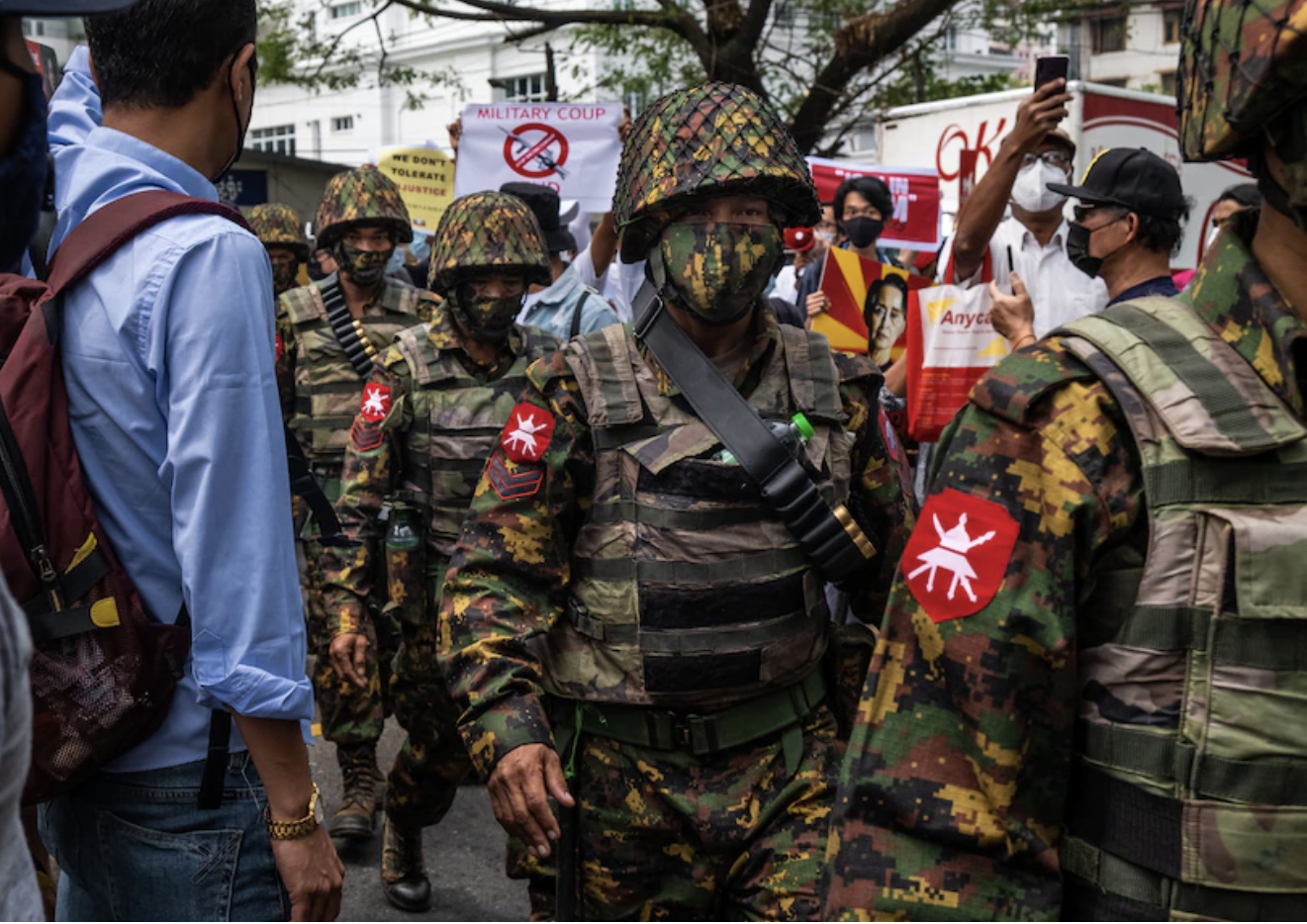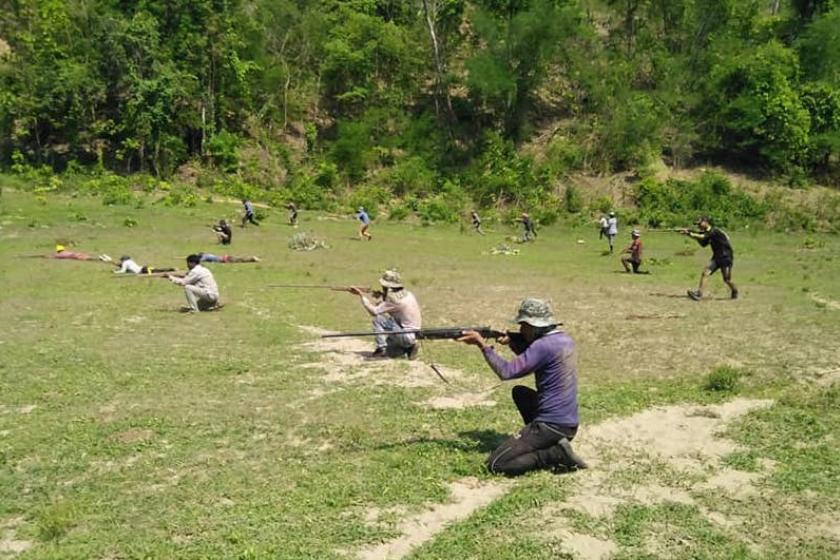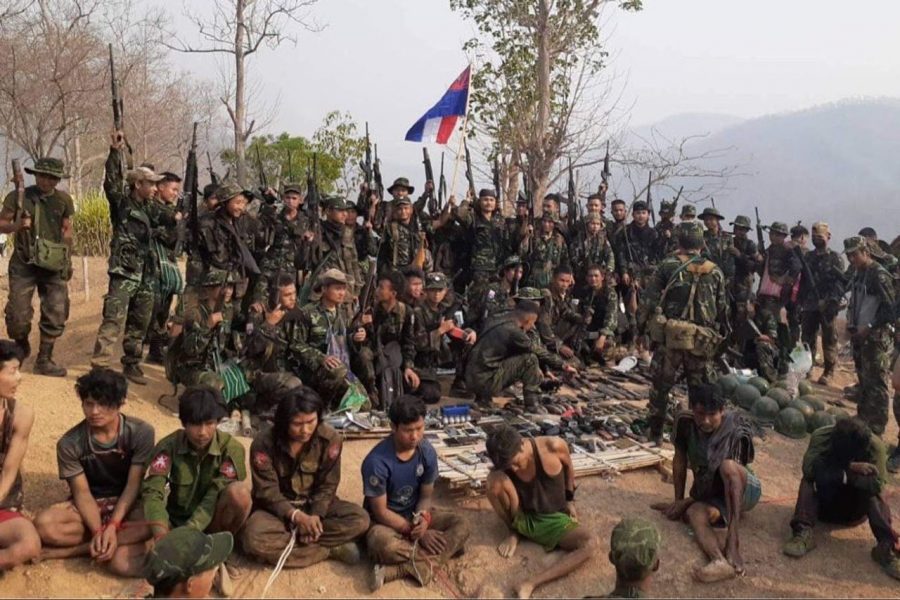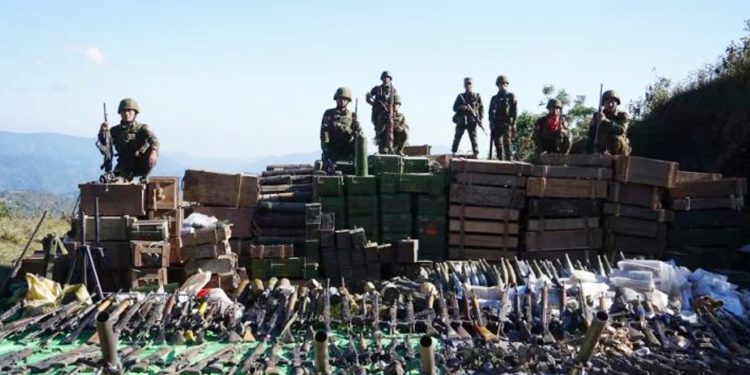Initially, the armed revolution against the junta popularly known as the Spring Revolution was underestimated by the Myanmar military, its sympathizers and political accomplices.
Similarly, the international community and neighboring countries may have publicly expressed support for democratization but they believed Myanmar’s military regime was too strong to fall.
The military and its supporters laughed at the shadow National Unity Government (NUG) when it declared a defensive war against the regime on September 7, 2021. The generals boasted they would crush the resistance stronghold of Sagaing Region within six months. Resistance battle cries were ridiculed.
Two and a half years later, the Spring Revolution is gaining momentum as it captures major bases and entire towns across the country. The Kachin Independence Army (KIA), Karen National Union (KNU), Karenni National Progressive Party, Chinland Defense Force, and All Burma Students Democratic Front (ABSDF) have allied with the NUG and its People’s Defense Force (PDF) armed wing.
The Arakan Army (AA), Ta’ang National Liberation Army (TNLA) and Myanmar National Democratic Alliance Army (MNDAA) have also started to engage with the democratic forces in central Myanmar, including the NUG and PDF.
Other revolutionary groups that have emerged in central Myanmar such as the People’s Liberation Army, Burma People’s Liberation Army, and Student Armed Force are also cooperating with ethnic armed organizations.
Resistance groups have mushroomed in central Myanmar as well as in Karenni (Kayah), Chin, Kachin and Shan states, launching the armed revolt with whatever weapons were available.
The major challenge facing the Spring Revolution has been funding and procurement of weapons. It therefore took time for resistance groups in central Myanmar to start fighting the regime.
Ethnic armed organizations (EAOs) have no trust in the country’s military. They are well acquainted with its divide-and-rule policy – to compromise and make temporary peace with one enemy so it can focus on crushing the other. They were aware the military would come for them if and when it could contain the resistance in central Myanmar.
Hence, seasoned EAOs supported the revolutionary forces while building themselves up and waiting for opportunities.

Before Operation 1027
The junta’s brutal crackdown on peaceful protests after the 2021 coup prompted widespread armed revolt in Kachin, Chin, Karen, Karenni, and Mon states and Sagaing, Magwe, Bago, Mandalay and Tanintharyi regions. Urban guerilla warfare was waged in Yangon and Mandalay cities. Of Myanmar’s seven regions, only Ayeyarwady struggled to kickstart an armed revolt.
Before the launch of Operation 1027 in late October last year, anti-regime forces had seized only Maese Township in Karenni State. However, they had gained control over much of rural Karen, Karenni, and Chin states, including key roads. The regime was forced to abandon its outposts and throw all its battalions into the fight.
Suffering heavy casualties in daily clashes with resistance forces, it committed massacres and conducted scorched-earth campaigns in Sagaing, Chin and Karenni in a bid to terrorize Myanmar civilians and deprive resistance groups of support. The atrocities only deepened the public’s hatred of the military. Ambush attacks on junta troops became commonplace and revolutionary forces were increasingly being armed.
An offensive that turned the tide
Despite the nationwide revolt in the aftermath of the coup, there were few clashes in Rakhine and Shan states which are home to powerful EAOs including the United Wa State Army, National Democratic Alliance Army, AA, TNLA, MNDAA, Shan State Progress Party, Restoration Council of Shan State and Pa-O National Liberation Organization.
They were silently expanding their armies while secretly helping the revolutionary forces. The regime was aware of these developments but too short-staffed to do anything about them. So, it attempted to draw them into peace talks.
The Brotherhood Alliance of the AA, TNLA, and MNDAA launched Operation 1027 on October 27, 2023 in northern Shan State. The AA also launched a separate offensive in Rakhine State in November. Unlike the previous isolated battles, Operation 1027 was a large-scale coordinated offensive.
Unable to provide reinforcements on the ground, the regime had to rely on air and artillery support. But just as the alliance was poised to attack Lashio, the offensive in northern Shan State was forced to halt under pressure from China. The fighting continues in Rakhine, however.
The alliance seized dozens of towns and more than 400 junta positions in northern Shan State in its nearly three-month-long offensive.
The operation has turned the tide of war, dealing a bitter blow to the regime.

Post-Operation 1027
The fighting came to a halt in early January, but the fighting continues in other parts of the country.
Rakhine front
The AA has seized Paletwa, Kyauktaw, Mrauk-U, Minbya, Myebon, Pauktaw, Ponnagyun, Ramree and Rathedaung towns, and occupied more than 40 junta positions including command headquarters.
Maungdaw, Buthidaung, Ann, Kyaukphyu, Taungup, Thandwe and Gwa are also under siege as the AA advances toward the state capital, Sittwe.
Sagaing Region
The regime launched counteroffensives earlier this year to retake Kawlin, Khampat, Shwe Pyi Aye and Mawlu towns and positions seized by resistance forces late last year. It has been only able to retake Kawlin, though resistance forces are still fighting regime troops on the outskirts of the town.
Resistance attacks have also been reported in Kale, Taze and Tigyaing since last month. Resistance attacks in the region were previously limited to ambushes, but they have now become offensives aimed at seizing towns.
Karenni State
Operation 1111 was launched in Karenni State following Operation 1027. Resistance forces were able to seize Nan Mae Khone town, Maese Township and half of the state capital, Loikaw. The offensive continues in Karenni despite the ceasefire in northern Shan State. Resistance forces have also seized Shadaw Township and Ywarthit and Mawchi towns and are attacking to seize Hpasawng town on the west bank of Salween River. They are also attacking between Pekon and Pinlaung towns.
Karen State
The Karen National Union (KNU) changed its tactics earlier this year, deploying three groups of troops consisting of KNU Brigade 6 and the PDF to make tactical assaults. One group attacked Kawkareik and has seized half the town. It also blew up a bridge on the Asian Highway leading to Myawaddy. Another group defeated a junta battalion in Thingannyinaung and an outpost in Falu, Myawaddy Township.
Another group attacked a junta hilltop outpost in Kyarinseikkyi Township last week. Over 60 junta soldiers including the commander surrendered.
The KNU apparently aims to recapture the bases and territory it lost to the Myanmar military before 2021. The regime appears incapable of resisting the KNU in this effort.
Kachin State
The KIA and allied forces have been attacking junta positions around Bhamo, Mabein and Hpakant towns since January.
They launched assaults on positions surrounding KIA headquarters in Laiza town in early March. They are currently attempting to seize Sumprabum town, after cutting off roads between Hpakant, Myitkyina and Bhamo.
The KIA seized around 30 junta positions including command headquarters and hilltop outposts in the first 10 days of its offensive. The Karenni Nationalities Defense Force, ABSDF, AA and PDFs are also involved in the Kachin offensive. Though the MNDAA and TNLA’s operations are limited to northern Shan State, the AA has expanded by cooperating with other resistance groups, including the KIA and PDFs.

Southern Shan
The Pa-O National Liberation Organization, which is a signatory to the Nationwide Ceasefire Agreement, declared war against the military dictatorship in late January, seizing Hsihseng and effectively opening a new front in southern Shan State. The regime has been unable to recapture Hsihseng one month after it was seized by the PNLO.
Wave after wave of offensives
The offensive in northern Shan State was a turning point in the Spring Revolution. Though Operation 1027 has ground to a halt, increased military operations in Rakhine, Kachin, Karen, and Karenni states and Sagaing Region will heighten military tensions in Chin and Mon states, Magwe, Bago, Ayeyarwady and Tanintharyi regions and Naypyitaw. Military operations in northern and southern Shan State will inevitably have impacts on ethnic armed groups in Shan State. Moreover, the ceasefire in northern Shan State does not necessarily mean that there will be no more fighting there.
The regime originally had around 5,280 headquarters, bases and outposts around the country but has so far lost control of 2,500, according to sources in the military. Over 1,000 were defeated while the rest were abandoned.
The resistance’s vow to launch ‘wave after wave’ of attacks is now materializing. Meanwhile, the junta’s early boasts are ringing increasingly hollow as its once-indomitable military collapses.
Moe Set Nyein Chan is a military analyst.

















